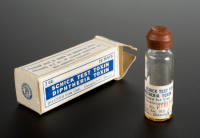








The Schick test, invented between 1910 and 1911 is a test used to determine whether or not a person is susceptible to diphtheria.It was named after its inventor, Béla Schick (1877–1967), a Hungarian-born American pediatrician.
The test is a simple procedure. A small amount (0.1 ml) of diluted (1/50 MLD) diphtheria toxin is injected intradermally into the arm of the person. If a person does not have enough antibodies to fight it off, the skin around the injection will become red and swollen, indicating a positive result. This swelling disappears after a few days. If the person has an immunity, then little or no swelling and redness will occur, indicating a negative result.
Results can be interpreted as:
Positive when the test results in a wheal of 5–10 mm diameter
Pseudo-positive when there is only a red colored inflammation and it disappears rapidly
Negative reaction
pseudo negative reaction The test was created when immunizing agents were scarce and not very safe, however as newer and safer toxoids were made available there was no more requirement for susceptibility tests.